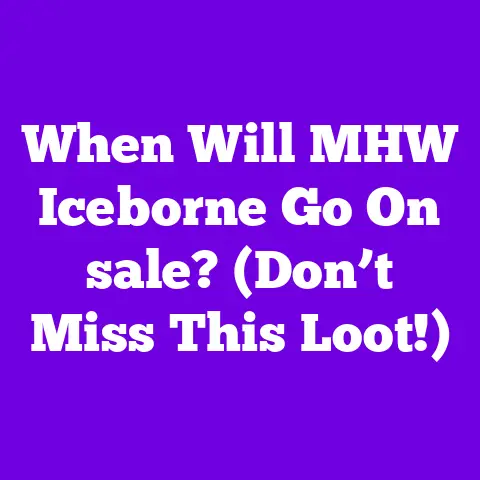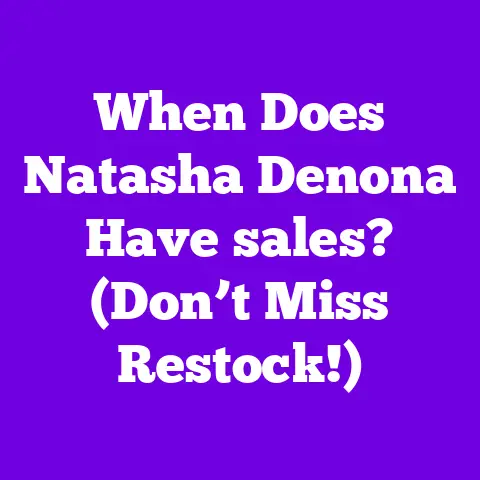Track sales Like a Pro! (Never Pay Full Price!)
Have you ever felt that pang of regret after buying something, only to see it go on sale a week later?
I know I have.
I remember splurging on a new laptop for $1200, convinced I was getting the best deal.
Fast forward two weeks, and it was advertised for $900 during a flash sale.
Talk about frustrating!
That experience ignited my passion for understanding and mastering the art of sales tracking.
In today’s world, where prices fluctuate like the stock market and our hard-earned money needs to stretch further than ever, becoming a savvy shopper is no longer a luxury; it’s a necessity.
We’re bombarded with marketing tactics designed to make us spend, often without considering the potential for savings.
That’s why I’m going to share my proven methods for tracking sales like a pro, ensuring you never pay full price in 2025.
Section 1: Understanding Sales Cycles
Sales cycles are the predictable patterns of price reductions that occur throughout the year.
They vary dramatically depending on the industry, product category, and even the specific retailer.
Understanding these cycles is the first step to becoming a master sale tracker.
Retail: In the retail sector, sales cycles are heavily influenced by seasons and holidays.
For example, clothing retailers typically have end-of-season sales to clear out inventory for new collections.
Summer clothing goes on clearance in late August/early September, while winter apparel sees discounts in February/March.
Electronics: The electronics industry follows a different rhythm.
New models are often released annually, leading to price drops on older versions.
For instance, Apple typically announces new iPhones in September, which triggers discounts on the previous generation.
Major electronics retailers like Best Buy and Amazon also hold large-scale sales events, such as Black Friday and Cyber Monday, offering deep discounts on a wide range of products.
Fashion: Fashion is notoriously cyclical.
Fast fashion brands churn out new collections every few weeks, resulting in frequent sales to make room for the latest trends.
High-end fashion brands, on the other hand, tend to have fewer, more strategic sales, often timed around the end of fashion weeks or specific holidays.
The Importance of Timing
Here’s a breakdown of key sales periods:
- January: White sales (linens and bedding), post-holiday clearance.
- February: Winter clothing clearance, Presidents’ Day sales.
- March: Luggage sales, St. Patrick’s Day deals (green items).
- April: Spring sales, Easter promotions.
- May: Memorial Day sales (outdoor furniture, appliances).
- June: Swimwear and summer apparel clearance.
- July: Amazon Prime Day (electronics, home goods), Back-to-School promotions begin.
- August: Back-to-School sales in full swing.
- September: Labor Day sales (appliances, mattresses), new iPhone announcements.
- October: Columbus Day sales, Halloween promotions.
- November: Black Friday (major discounts across all categories).
- December: Cyber Monday (online deals), last-minute holiday sales.
Predicting Sales Cycles
Predicting sales cycles involves analyzing historical data and market trends. I use several methods:
Historical Data: Websites like CamelCamelCamel (https://camelcamelcamel.com/) allow you to track the price history of products on Amazon.
By analyzing past price fluctuations, you can identify patterns and predict when a product is likely to go on sale again.Example: I once used CamelCamelCamel to track the price of a specific model of headphones I wanted.
I noticed it consistently went on sale for 20% off every November and April.
Based on this data, I waited until the next November and snagged the headphones at the discounted price.Market Trends: Stay informed about industry news and market trends.
For example, if there’s a buzz about a new gaming console being released, you can anticipate price drops on the current generation.
Example: I follow tech news sites like The Verge (https://www.theverge.com/) and Engadget (https://www.engadget.com/) to stay ahead of the curve on electronics releases.Retailer Newsletters: Sign up for email newsletters from your favorite retailers.
They often announce upcoming sales and promotions in advance.
Example: I subscribe to the email lists of retailers like Target, Macy’s, and Nordstrom to get early access to sales information.Social Media: Follow retailers and influencers on social media platforms like Twitter, Instagram, and Facebook.
They frequently share exclusive deals and promotions.
Example: I follow several fashion bloggers on Instagram who often post discount codes and sale alerts for their favorite brands.
Section 2: Tools and Technologies for Tracking Sales
In today’s digital age, we have a plethora of tools and technologies at our disposal to help us track sales effectively.
Here are some of my favorite resources:
Price Tracking Apps and Websites
Honey: Honey (https://www.joinhoney.com/) is a browser extension that automatically searches for and applies coupon codes when you’re shopping online.
It also offers price tracking features, notifying you when the price of an item you’re watching drops.Example: I recently used Honey to purchase a new coffee maker.
It automatically applied a 15% off coupon code, saving me $10.
* CamelCamelCamel: As mentioned earlier, CamelCamelCamel is a fantastic resource for tracking Amazon prices.
You can set up price alerts and receive email notifications when a product reaches your desired price.
* ShopSavvy: ShopSavvy (https://shopsavvy.com/) is a mobile app that allows you to scan barcodes and compare prices across multiple retailers.
It also provides price history data and alerts you to upcoming sales.Example: I use Price.com to find the best deals on electronics and appliances.
Social Media and Online Communities
Social media platforms and online communities are invaluable resources for sharing sales information and tips.
- Reddit: Subreddits like r/frugalmalefashion, r/frugalfemalefashion, and r/deals are dedicated to sharing deals and discounts on clothing, electronics, and other products.
- Facebook Groups: There are numerous Facebook groups dedicated to specific types of deals, such as travel deals, couponing, and freebies.
-
Twitter: Follow retailers and deal-hunting accounts on Twitter to stay updated on the latest sales and promotions.
Example: I regularly check Reddit’s r/deals subreddit to find discounts on products I’m interested in.
Table of Price Tracking Tools:
Section 3: Strategies for Smart Shopping
Now that we’ve covered sales cycles and the tools available, let’s dive into some actionable strategies for tracking and capitalizing on sales.
Setting Price Alerts and Using Comparison Shopping Tools
- Price Alerts: As mentioned earlier, many price tracking apps and websites allow you to set up price alerts.
This is a crucial step in ensuring you never miss a deal. - Comparison Shopping: Before making a purchase, always compare prices across multiple retailers.
Use websites like Google Shopping or PriceGrabber to find the best deal.
Creating a Wishlist and Timing Purchases Strategically
- Wishlist: Create a wishlist of items you want to buy.
This helps you stay organized and focused on your priorities. Strategic Timing: Track the prices of items on your wishlist and wait for them to go on sale before making a purchase.
Example: I maintain a running wishlist on Amazon of items I’m interested in.
I regularly check the prices and wait for them to drop before adding them to my cart.
Utilizing Cashback Programs and Rewards Credit Cards
Cashback Programs: Sign up for cashback programs like Rakuten (https://www.rakuten.com/) or TopCashback (https://www.topcashback.com/).
These programs offer a percentage of your purchase back in cash.Example: I always start my online shopping by going through Rakuten.
I’ve earned hundreds of dollars in cashback over the years.
* Rewards Credit Cards: Use a rewards credit card that offers cashback or points on purchases.
Pay off your balance in full each month to avoid interest charges.Example: I use a credit card that gives me 2% cashback on all purchases.
This helps me save even more money on top of sales and discounts.
Real-Life Case Studies
Black Friday and Cyber Monday
Black Friday and Cyber Monday are the biggest shopping days of the year, offering deep discounts on a wide range of products.
-
Preparation:
- Make a Shopping List: Create a list of items you want to buy and prioritize them.
- Research Products: Research the products you’re interested in and compare prices at different retailers.
- Understand Store Policies: Familiarize yourself with store policies, such as return policies and price matching.
- Start Early: Many retailers start their Black Friday sales early, so be sure to check for deals in the weeks leading up to the event.
-
Tips:
- Shop Online: Avoid the crowds and shop online.
- Use Coupon Codes: Look for coupon codes to save even more money.
- Take Advantage of Price Matching: Many retailers offer price matching, so be sure to take advantage of this policy.
Amazon Prime Day
Amazon Prime Day is an annual sales event exclusively for Amazon Prime members.
-
Preparation:
- Become a Prime Member: If you’re not already a Prime member, sign up for a free trial.
- Create a Wishlist: Add items you want to buy to your wishlist.
- Follow Amazon on Social Media: Stay updated on the latest deals and promotions by following Amazon on social media.
-
Tips:
- Shop Early: Prime Day deals often sell out quickly, so be sure to shop early.
- Check for Lightning Deals: Lightning Deals are limited-time deals that offer significant discounts.
- Use the Amazon App: The Amazon app allows you to easily track deals and make purchases on the go.
Emerging Trends in Sales Events
- Virtual Sales: Virtual sales are becoming increasingly popular, allowing shoppers to browse and purchase items from the comfort of their own homes.
- Exclusive Online Offers: Retailers are offering more and more exclusive online offers, making it even easier to save money while shopping online.
- Sustainable Shopping Events: Sustainable shopping events are gaining traction, with retailers offering discounts on eco-friendly and ethically sourced products.
Section 5: The Psychology of Sales and Consumer Behavior
Understanding the psychological tactics used by retailers can empower you to make informed decisions and avoid impulse buying.
Scarcity, Urgency, and Social Proof
- Scarcity: Retailers often create a sense of scarcity by limiting the quantity of items available or by indicating that a product is “low in stock.” This tactic is designed to make you feel like you need to act quickly before the product sells out.
- Urgency: Retailers use urgency by creating limited-time offers or flash sales.
This tactic is designed to make you feel like you need to make a purchase immediately or risk missing out on a great deal. - Social Proof: Retailers use social proof by displaying customer reviews, testimonials, and ratings.
This tactic is designed to make you feel like you’re making a smart decision because other people have had positive experiences with the product.
Cultivating a Mindset That Prioritizes Value Over Desire
- Identify Your Needs: Before making a purchase, ask yourself if you truly need the item or if you just want it.
- Set a Budget: Create a budget and stick to it.
This will help you avoid overspending and impulse buying. - Practice Mindfulness: Take a moment to pause and reflect before making a purchase.
Ask yourself if you’re making a rational decision or if you’re being influenced by marketing tactics. - Prioritize Value: Focus on the value of the product rather than the price.
Consider the quality, durability, and usefulness of the item.
Conclusion
Tracking sales is an essential skill for the modern shopper.
By understanding sales cycles, utilizing price tracking tools, implementing smart shopping strategies, and being aware of psychological tactics, you can confidently navigate the shopping landscape in 2025 without ever paying full price.
Take the knowledge I’ve shared and start implementing these strategies today.
The potential savings are immense, and you’ll feel empowered knowing you’re making informed and financially sound decisions.
Embrace your inner “sale tracker” and get ready to conquer the world of discounts!
References and Resources
- CamelCamelCamel: https://camelcamelcamel.com/
- Honey: https://www.joinhoney.com/
- ShopSavvy: https://shopsavvy.com/
- Price.com: https://www.price.com/
- Rakuten: https://www.rakuten.com/
- TopCashback: https://www.topcashback.com/
- The Verge: https://www.theverge.com/
- Engadget: https://www.engadget.com/






